Recamier Manufacturing Company
In 1886, Harriet Hubbard Ayer founded the Recamier Manufacturing Company at 25 Union Square, New York. Incorporated in 1887, the company’s product range addressed most of the beauty concerns of the day. The cosmetics were restricted to skin-care and did not include decorative products such as rouge or lipstick – these were still considered to be ‘paints’ and therefore unsuitable for general use in polite society. The company therefore produced, marketed and sold ‘toilet preparations’ rather than ‘cosmetics’.
Harriet Hubbard Ayer
Who’s Who in America (1901) described Harriet Hubbard Ayer as follows:
Ayer, Harriet Hubbard, journalist, author; b. Chicago, 1854; d. Henry G. and Juliet Elvira Hubbard; grad. Sacred Heart Convent, Chicago, 1869; m. Chicago, 1869, Herbert Copeland Ayer (died, 1899). Born and reared in luxury, married at 16 to man of large wealth; society leader; extensive traveler, linguist, woman of fashion. In 1883 husband failed for over $2,000,000. She voluntarily gave up her home and all her belongings for benefit of her husband’s creditors, and went into trade; established mfg. business; cleared $200,000 in 4 yrs. Ill health forced her to give up management of business, which lost money from the date of her retirement. In 1894 retired from commercial life to accept editorial position on New York World; has educated her daughters in best European schools and has maintained her family without aid; now the highest paid woman journalist in U. S. Author: Harriet Hubbard Ayer’s Book, New York, 1900. Residence: 129 E. 17th St. Office: New York World, New York.
(Who’s Who in America, 1901)

Above: 1885 Before establishing Recamier, Harriet Hubbard Ayer sold furniture and clothing. She started out working for Messrs. Sypher & Co. but in 1883 she branched out on her own.
Who’s Who passes over the bitter battle for control of the company. In 1893, her main financial backer, James Seymour, and his son, Lewis Seymour, arranged to get Ayer’s ex-husband and daughter (who was married to Lewis Seymour) to commit Harriet to a sanatorium. Although later released on a technicality, she was unable to regain control of the business and retired from its operations. After ‘retiring’ from Recamier, Ayer took up lecturing and from 1896 wrote a regular beauty column for Joseph Pulitzer’s New York World newspaper, offering advice to women on the ‘laws of beauty’, later becoming the coordinator of the women’s page. Material from these columns formed the basis for a book, ‘Harriet Hubbard Ayer’s Book of Health and Beauty’, published in 1902.
The company Harriet founded did not long outlive her departure, going into receivership in 1896. The lurid nature of the widely reported court cases – which included allegations of insanity, poisoning, theft and general treachery – may have been a factor in its demise.
The corporate assets of the Recamier Manufacturing Company were bought by Maria Rinn, a former employee, for $4,000 at the 1896 receiver sale. She continued the business until 1920 when she sold it to Anna Reynolds. How successful these ventures were is unknown to me.
Origins
The recipes for her skin care products were claimed by Harriet to have come from a French countess said to be a descendant of Madame Jeanne Françoise Julie Adélaïde Récamier, a well known beauty from Napoleonic times. The recipes that Madame Récamier’s used had supposedly been handed-down to the countess and she sold copies to Harriet. The concoction of this story was a great marketing idea by Harriet as it gave her company a name, a visible symbol of beauty, and some supposed ‘beauty secrets’ from France, the centre of fashion and beauty at the time.
Another version of the story states that on a trip to Paris, Harriet visited a certain M. Mirault who made the Parma Violet Perfume she used. M. Mirault had a formula for a skin salve his grandfather had made for Julie de Récamier and he sold it to Harriet for a ‘tremendous price’.
A third explanation for the origins of the cream came in 1889 when Harriet was sued by Lutie Frenzel. Lutie suggested that the French-made cream had been analysed by a New York chemist and subsequently copied (Blaugrund, 2011).
Distribution
As the department store cosmetic counter had yet to come into existence, the company’s products were distributed through drugstores, fancy good dealers or by mail order. Like patent medicine suppliers, Harriet advertised widely in newspapers and on billboards.
Product endorsement
Harriet Hubbard Ayer was an early pioneer of product endorsement and paid celebrities to associate their name with her products. Society women and clergymen were commonly used, as well as actresses including Lillian Russell, Cora Brown Potter, Sarah Bernhardt and Fanny Davenport. Ayer also enlisted ‘eminent scientists’ to attest that her products were free of harmful chemicals such as lead, bismuth and arsenic.
Product Range

Above: 1893 Recamier Balm, Moth & Freckle Lotion, Soap and Face Powder.
Recamier Toilet Preparations included cosmetics and patent medicines.
Recamier Toilet Cream: “made from a recipe used by Julie Recamier. It is not a cosmetic, but an emollient to be applied at night just before retiring, and to be removed in the morning by bathing freely. It will remove tan and sunburn, pimples, red spots or blotches, and make your face and hands as smooth, as white and as soft as an infant’s.”
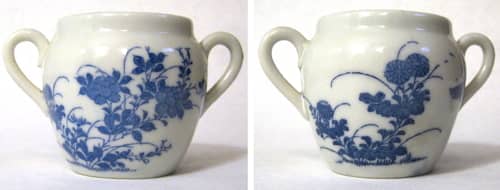
Above: Two sides of a jar of Recamier Toilet Cream. The lid that was held on with a ribbon is missing. This may have been a later version of the pot as images of early pots were drawn with a solid colour. Blaugrund suggests that these may have been blue. “The mixture was set in a delicate blue china jar similar to a covered sugar bowl, and the handles were tied with a ribbon to keep the cover attached” (Blaugrund, 2011, p. 82).
Recamier Balm: “a beautifier, pure and simple. It is not a whitewash, and, unlike most liquids, Recamier Balm is exceedingly beneficial and is absolutely imperceptible except in the delicate freshness and youthfulness which it imparts to the skin.”
Recamier Moth & Freckle Lotion: “will remove freckles and moth patches, is soothing and efficacious for any irritation of the cuticle, and is the most delicate of washes for removing the dust from the face after travelling, and is also invaluable to gentlemen to be used after shaving.”
Recamier Wrinkle Specific: “the successful tissue builder.”
Recamier Depilatory: “guaranteed to remove superfluous hair permanently, without pain or inflammation on or after application.”
Recamier Powder: “the finest powder ever manufactured, and is delightful in the nursery, for the gentlemen after shaving and for the toilet generally.” Shades: White, Flesh and Cream.
Recamier (Toilet) Soap: “a perfectly pure article, guaranteed free from animal fat. This soap contains many of the healing ingredients used in compounding Recamier Cream and Lotion.”
Recamier Sarsaparilla: “avoids the use of iodine of potash, mercury in any of its combinations, or any other mineral substance except phosphate of iron. The phosphorous gives nourishment to the brain, the iron strength to the blood. … enriches the blood at the same time as it purifies it.”
Vita Nuova (New Life): “a tonic suitable to stimulate and strengthen the nervous system, it is invaluable in cases of dyspepsia and indigestion.”
Note: The spelling of Recamier varies, sometimes including the accent, sometimes not.
Product formulae
The Boston Journal of Health, the Western Druggist and New Idea published articles critical of available patent medicines and other chemical preparations. Recamier products were included in their investigations. Their concerns were the exorbitant prices Ayer charged, the presence of dangerous ingredients – such as corrosive sublimate also know as bichloride of mercury – and the exorbitant and misleading claims made by her for Recamier products. As part of their investigation they analysed and published the chemical compositions of a number of Recamier toiletries as well as Recamier Vita Nuova.
Ayer’s (Mrs. Harriet Hubbard) Recamier Balm.
Recamier Balm comes in a cheap glass flask, tied with a bit of ribbon and filled with water; contains a white powder—the oxide of zinc—and corrosive sublimate. This preparation is sold for $1.50. It costs, at most, to make it, ten cents. —Boston Journal of Health.
Since the analysis of the Boston Journal of Health came to the writer’s notice, R. G. Eccles has examined Recamier Balm, which he states in the Druggists’ Circular to contain substantially 20 grains corrosive sublimate and 60 grains zinc oxide.
Ayer’s (Mrs. Harriet Hubbard) Recamier Cream.
The Western Druggist gives the formula for Recamier Cream:
Take of—
Oxide of zinc 2 oz. Glycerine 60 dr. Water 1 dr. Spirits of rose (4 drs. to pint) 1 dr. Triturate together until a perfectly homogeneous mass results.
Ayer’s (Mrs. Harriet Hubbard) Recamier Moth and Freckle Lotion
Recamier Moth and Freckle Lotion contains corrosive sublimate in almond paste or emulsion with water. It is sold for $1.50. It costs, at most, ten cents. —Boston Journal of Health.
Ayer’s (Mrs. Harriet Hubbard) Recamier Powder
Recamier Powder contains arrowroot and oxide of zinc. It is put up in a pasteboard box, and is sold for $1.00. Its actual cost is about five cents. —Boston Journal of Health.
Ayer’s (Mrs. Harriet Hubbard) Recamier Soap.
Recamier Soap is an ordinary toilet soap, such as is usually sold for ten cents. Harriet Hubbard Ayer sells it for twenty-five cents. For the same, scented, fifty cents is asked.
These, then, are the famous “Recamier preparations,” the secret of which was obtained, according to the circular which accompanies them, “by Mrs. Ayer from a French countess, a relative of Madame Recamier! ” And what are they? Cheap, ordinary preparations, known from time immemorial, and condemned by physicians on account of the corrosive sublimate—a deadly poison which most of them contain. —Boston Journal of Health.
Ayer’s (Mrs. Harriet Hubbard) Recamier Vita Nuova (New Life.)
“A life-giving and health renewing cordial and tonic. Unsurpassed in excellence as a restorative, effecting marvelous cures in all cases of mental exhaustion, general debility, nervous prostration, insomnia, dyspepsia, hysteria in its many forms, neuralgia and congestive headaches, etc., etc. ” “A positive cure for the opium and alcohol habits. Dose: half of a claret glassful, or about three tablespoonfuls three times a day, with meals. In addition to this it can be taken as necessity requires after any unusual labor, mental or physical.” Price, $1.00 a bottle. In addition to this, the circular which accompanies it makes the specific statement that, though tasting like a wine 30 years old, it is positively free from alcohol or narcotics, and that it is free from “reactionary effects.” “It creates no craving and can be left off at any moment without the slightest desire for it.”
In the July, 1888, New Idea, we published the analysis of this nostrum which was made by the Boston Journal of Health. This analysis made it out to be simply a port wine, containing between 18 and 19 per cent, alcohol. Since then, Dr. R. G. Eccles published in the Druggists’ Circular a lengthy article on the Hubbard-Ayer preparations, and calls attention particularly to the presence of cocaine in the Vita Nuova. We have recently examined this preparation also and find it to contain notable quantities of cocaine easily detected by the organo-leptic test, and also about 19½ per cent., by volume, of alcohol. —New Idea.(Oleson, 1903, pp. 10-13)
See also Mercolized Wax and Freckle Removers.
The Harriet Hubbard Ayer Company
Harriet Hubbard Ayer’s name lived on although in a different company. After her death the rights to the ‘Harriet Hubbard Ayer’ name were obtained by Vincent Benjamin Thomas [1868-1918] from Harriet’s daughter Margaret [1877-1965] and in 1907 he founded a company in her name. Apart from the name, the Harriet Hubbard Ayer Company, known mainly for its Luxuria line of products, had no relationship with the Recamier Manufacturing Company and was not, as some have suggested, a continuation.
See also: Harriet Hubbard Ayer
Timeline
| 1882 | Harriet Hubbard Ayer leaves her husband and moves to New York. |
| 1883 | Harriet Hubbard Ayer begins working for Sypher & Co., an antique and bric-a-brac business, and begins frequent buying trips to Europe. |
| 1886 | Recamier Manufacturing Company founded by Harriet Hubbard Ayer at 25 Union Square, New York. |
| 1887 | Recamier Manufacturing Company is incorporates. Additional premises opened at 39-41 Park Place, New York. Factory and wholesale business later moved to 52-54 Park Place, New York. Recamier products go on sale in England at the American Exhibition and the Wild West Show. |
| 1890 | Harriet Hubbard Ayer establishes a larger retail shop at 305 Fifth Avenue, New York |
| 1893 | Harriet Hubbard Ayer committed to a sanatorium, declared insane and loses control of the company. Court case follows. |
| 1894 | Harriet Hubbard Ayer freed but unable to regain control of her company and retires from commercial life. |
| 1896 | Recamier Manufacturing Company goes into receivership. Assets bought by Maria Rinn. Harriet Hubbard Ayer begins writing health and beauty articles for the New York World newspapers. |
| 1900 | Harriet Hubbard Ayer becomes the editor of the women’s pages for the New York World. |
| 1902 | Harriet Hubbard Ayer publishes ‘Harriet Hubbard Ayer’s Book of Health and Beauty’. |
| 1907 | Vincent Benjamin Thomas establishes the Harriet Hubbard Ayer company using the naming rights he obtained from Margaret Hubbard Ayer. |
| 1920 | Recamier Manufacturing Company sold to Anna Reynolds. |
Updated: 4th December 2016
Sources
Allen, E. (Ed.). (1961). The book of beauty. London: George Newnes.
Blaugrund, A. (2011). Dispensing beauty in New York & beyond. The triumphs and tragedies of Harriet Hubbard Ayer. Charleston: The History Press.
New York Times (1886). Newspaper.
Oleson, C. W. (1903). Secret nostrums and systems of medicine: A book of formulas (10th ed.). Chicago: Oleson & Co.
Victoria Daily Colonist. (1890). Newspaper.
Leonard, J. W. (Ed.). (1901) Who’s Who in America. (1901). Chicago: A. N. Marquis & Co.
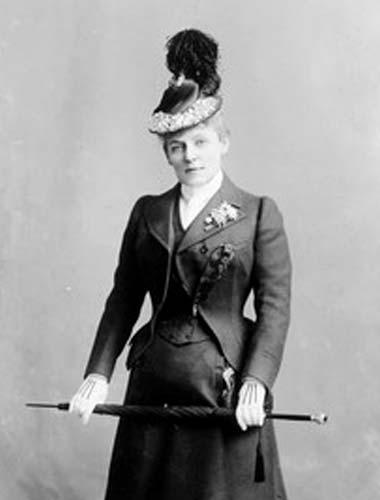
Harriet Hubbard Ayer [1849-1903].
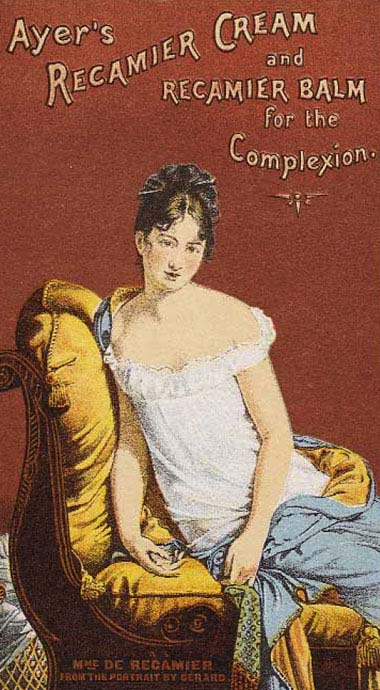
Advertising card circa 1890s for Ayer’s Recamier Cream showing a picture of Madame de Recamier based on a portrait by François Pascal Simon, Baron Gérard, 1802.
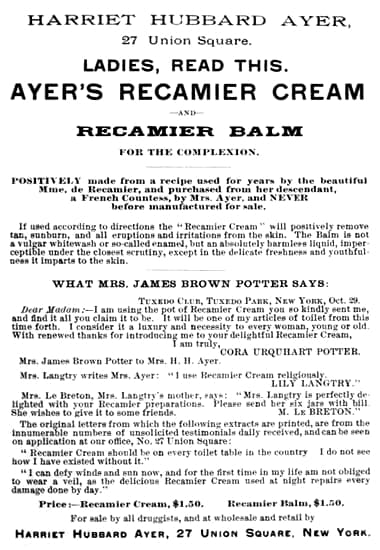
1887 Recamier Cream with product endorsements.
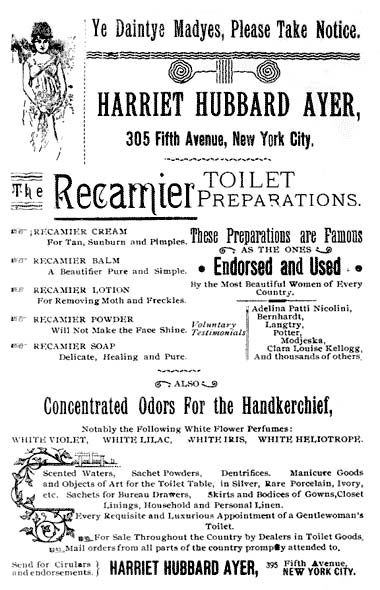
Recamier Toilet Preparations detailing the range of products available.
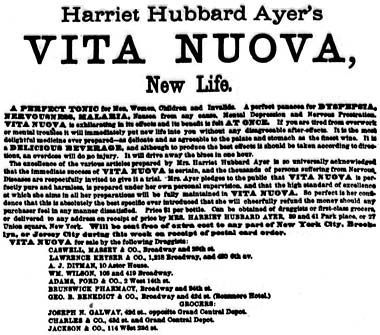
1887 Harriet Hubbard Ayer’s Vita Nuova. The advertisement suggests that it treats dyspepsia, nervousness and malaria.
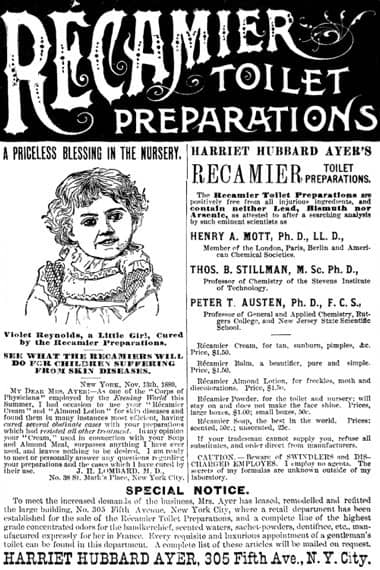
1890 Récamier Toilet Preparations.
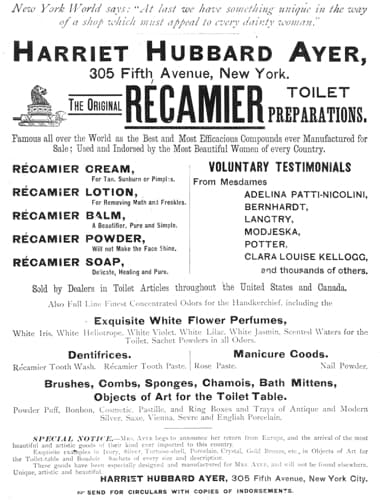
1891 Récamier Toilet Preparations detailing the range of products available. Note the Recamier logo.
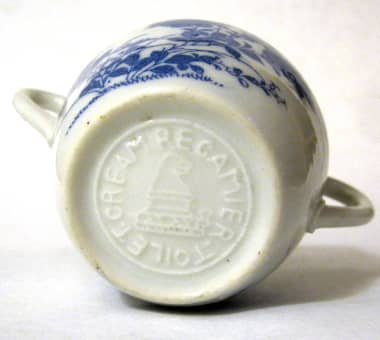
Recamier logo on the bottom of a jar of Récamier Toilet Cream. It consisted of fasces (a bundle of rods containing an axe with the blade projecting, a Roman emblem of official power) surmounted by a coronet, out of which rises the head of a lion.

1893 Récamier Toilet Preparations.
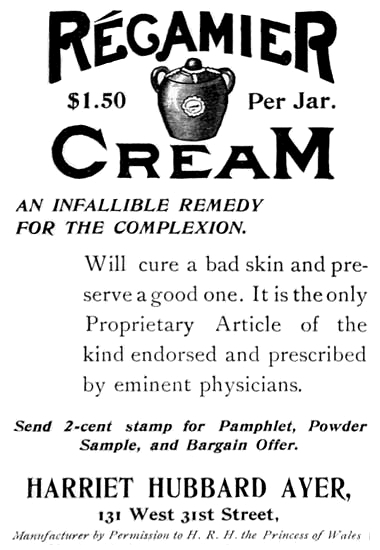
1895 Récamier Toilet Cream.
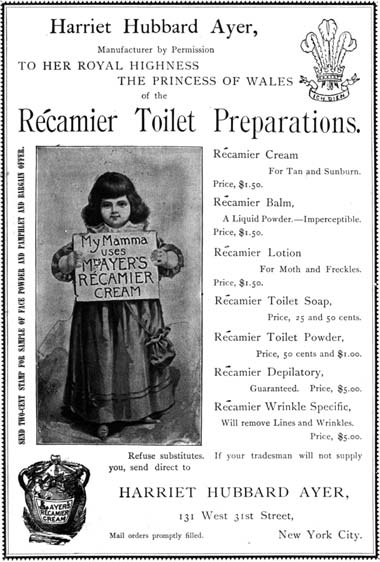
1895 Récamier Toilet Preparations. The Royal endorsement claimed here is presumed to be bogus.
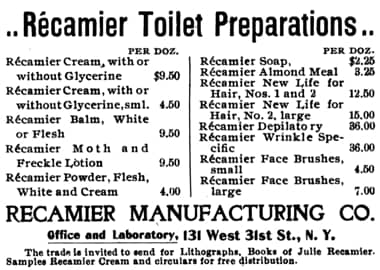
1905 Récamier Toilet Preparations.
